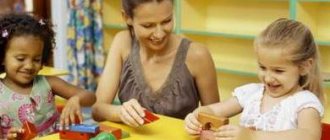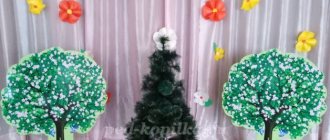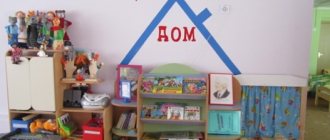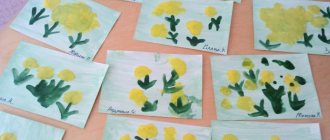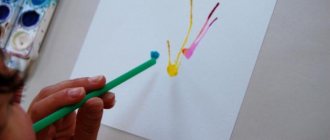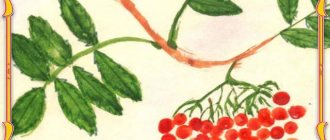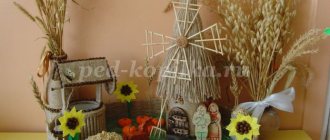How to choose a topic for self-education?
There are only two main criteria:
- requirement to study the topic from the outside (formulated in regulatory documents, in particular, in the Federal State Educational Standard for Preschool Education);
- the work of the teacher himself (lack of experience and knowledge to resolve a particular pedagogical situation).
Thus, before choosing a topic, you need to familiarize yourself with the regulatory framework for preschool education and analyze your own experience.
According to the Federal State Educational Standard, a preschool child develops in the following areas:
- social and communicative;
- educational;
- speech;
- artistic and aesthetic;
- physical.
Approximate topics of self-education for a preschool teacher according to the Federal State Educational Standard (2017 and later)
In accordance with the identified areas, topics on self-education for kindergarten teachers according to the Federal State Educational Standard can be as follows:
- Methods and means of amplification of preschool child development.
- Pedagogical diagnostics in a preschool institution.
- Individual approach in preschool education.
- Means and methods of developing safe life skills in preschoolers.
- Development of emotional intelligence in preschoolers.
- Guiding the play activities of preschool children.
- Cultivating kindness in preschoolers.
- Raising responsiveness in preschool children.
- Fostering sense of purpose in preschool children.
- Cultivating honesty and truthfulness in preschoolers.
- Formation of ideas about the small homeland among preschoolers.
- Development of creative abilities in preschool children.
- Formation of prerequisites for educational activities in children of senior preschool age.
- Cultivating curiosity in preschoolers (in classes, in communication, play, work).
- Formation in preschoolers of ideas about the signs, qualities and properties of objects in the surrounding world.
- Familiarization of preschoolers with the biocenosis of a forest (meadow, pond).
- Formation of ideas about space in preschoolers.
- Formation of ideas about inanimate nature in preschool children (natural phenomena, seasons, change of day and night).
- Formation in preschoolers of ideas about the shape, size, spatial relationships of objects.
- Formation of the concept of number in preschoolers.
- Development of forms of communication in preschoolers.
- Development of coherent speech in preschool children (in communication, play).
- Teaching children 4-7 years old basic analysis of a literary work.
- Teaching preschoolers to retell literary works.
- Teaching preschoolers to read poems expressively.
- Creative storytelling in kindergarten.
- Literacy training in preschool educational institutions.
- Non-traditional techniques of visual activity in kindergarten.
- Health-saving technologies in preschool education.
- Formation of cultural and hygienic skills in children of early and preschool age.
- Formation of self-service skills in preschoolers.
- Creating psychological comfort in a preschool group.
- Computer technologies in preschool education.
- Continuity of preschool and primary education.
- Psychological and pedagogical assistance in the family in the education and development of preschool children.
In 2016, changes and additions were made to the Federal State Educational Standard, in particular, on the education of children with disabilities. In this regard, one of the self-education topics for kindergarten teachers according to the Federal State Educational Standard 2022 could be:
- "Inclusive education in preschool settings."
In addition to topics in a specific area, you can choose a topic related to the work of a preschool institution as a whole:
- Planning work in a preschool institution according to the Federal State Educational Standard.
- Developing subject-spatial environment in preschool educational institutions.
- Development of partial preschool education programs.
- Innovative forms of working with parents of preschool children.
The list of topics on self-education for kindergarten teachers according to the Federal State Educational Standard 2022 may include the following topics:
- Variability of preschool education services at the present stage.
- Experimental activities in preschool educational institutions.
- Quality of preschool education: evaluation criteria.
- Social relations in preschool education.
Self-study notebook with notes in the margins
Having determined the “basis” for yourself, as you read further these books, you write out for yourself: forms (forms of organizing the educational process: individual, pair, group, frontal), methods (methods of pedagogical activity). I advise you to read a textbook on pedagogy for pedagogical schools, author Smirnov (I don’t remember his name and patronymic right now), year of publication - after 2000, but no one has yet described the methods and techniques of pedagogical activity better than him. Just don’t take the classification of methods by Yu.K. Babansky. I have a great attitude towards him, but he died in 1985 (23 years ago!!!! :() and during this time his classification has simply become outdated. With Babansky’s classification you will not be able to model your professional informatization activities competently, in a modern way), means , conditions. You see, I have already sketched out a 5-point plan for you. At each point, you choose for yourself those that you understand, accept and are able to implement. I didn’t say the main thing at first: in order to take on the topic of informatization, you need to take INFORMATICS. Otherwise, you need to link to the following topic of self-education: “Elimination of computer illiteracy.” Don't be surprised - this is a very good topic!
(to be continued)
Scheme for planning work on self-education. Another option
Planning of self-educational work (scheme) Individual self-education plan for _____year Teacher ____________________________________ Direction of the circle___________________________ Full name _____________________________________ Education (when and what educational institution did you graduate from) __________ When did you take courses _____________________ What literature does you study during the year ________ Where and when did you speak on the topic? ___________________ Self-educational work on the topic: 1. Topic CTDM. 2. Individual topic of self-education. 3. When work on the topic began. 4. When is it expected to finish working on the topic. 5. Goals and objectives of self-education on the topic. 6. Main issues planned for study. Stages of material development. 7. Literature on the topic, by year. 8. Whose experience is expected to be studied on this topic. 9. Creative cooperation on the topic of self-education. 10. Practical outputs (reports, abstracts). 11. Study of best practices (how many lessons and extracurricular activities attended). 12. When and where did he give a report on his own teaching experience? 13. Conclusions at the end of the work.
Having built a “theory” of the problem for yourself, begin to implement it on your favorite topic of ONE lesson. If you have several classes in parallel (a teacher’s dream!!!!), then in the first year of your self-education (and your mini-research) you will be able to test your FIRST achievements in ONE class, comparing the results obtained (children’s learning). Those. You will have one class as a control class (you work as usual), and the other as an experimental class. The most acceptable way to check the results: give the same measures (for example, tasks, examples). In this case, you need to pay attention: classes are always different in their abilities. Experiment in a weak class!!! (This is the rule of pedagogical science: achieve good results in a weak class!). Then reflect on the results obtained very honestly for yourself. Record everything (graphs, questionnaires, etc.). Of course, there will be a need to redo something, add something, etc. And again - record (what was changed, why, what was replaced). And throughout the next year, engage in “self-education”: read, read and read on your problem “Informatization”, including articles from pedagogical journals (fortunately, there are now a lot of electronic ones), articles from scientific and practical conferences (unfortunately, teachers they are not read at all, but they contain the most valuable new experience!!!).At this stage, it would be very great if you got acquainted with the work experience of your colleagues (in the educational institution, district, city, Russia) on this problem (how to do this, I think there is no need to explain). And keep thinking and thinking: what needs to be done for a perfectly informatized favorite lesson! In the second year, teach your favorite topic in a new way. And again - a cross-section of learning skills (if you use the same diagnostic tools: tasks, examples, then you will very easily see “growth over growth”!. That is, a comparison of work both in the old and in the new way: You teach children (“growth”), but innovation should (or maybe not) lead to the better (“growth”!) If this happens, “a medal on your chest and a monument during your lifetime!” So, your topic is self-education "works" positively! And then, the next year, you "expand" the area of the experiment: take two lessons, a whole topic. And that's enough!!! Believe me, I've seen more than a dozen candidate dissertations "done" on one topic . I think you understand: the topic is in one class, for example, in the 5th. If there is a need, “expand in breadth,” but better “in depth.” Use other programs (we are talking about informatization), other tasks, introduce computer control knowledge and everything on your FAVORITE topic. And then: open classes (on this topic), seminars, master classes, etc. Of course, I have now very schematically given you not only the technology of self-education (maybe even to a lesser extent), but also recording its results. I think my recommendations will be useful.
How to work by topic
Work on each of the listed topics begins with an analysis of the literature (an approximate list of sources is given below). When reading books, the teacher identifies the main thoughts, ideas, and judgments of the authors. So, taking up the topic of using didactic games to develop safe life skills in children, the teacher:
- draws attention to the peculiarities of organizing didactic games in different age groups;
- content of work on life safety in preschool educational institutions.
Then the teacher thinks through or also takes from books potentially dangerous situations that need to be avoided, and based on the knowledge gained, compiles a card index of games. He develops games himself or takes them from sources. Systematized materials are tested in practice.
MAGAZINE Preschooler.RF
Self-education plan for the 2020–2021 academic year on the topic: “Non-traditional drawing techniques”Middle group Teacher of the 1st category: Atnagulova Nailya Galievna
Self-education plan on the topic: “Drawing with non-traditional techniques” (middle group) for the 2022 – 2021 academic year.
Goal: to develop children's creative abilities through non-traditional drawing.
Objectives of self-education work:
- Study the literature on this topic.
- Familiarization with innovative technologies using non-traditional drawing techniques.
- Draw up a work plan on this topic.
- Prepare consultations for parents on this topic.
- To form knowledge in children of middle preschool age about non-traditional methods of drawing;
- Teach students to independently use non-traditional drawing techniques;
- To develop children's creative abilities, fine motor skills, thinking, imagination, attention, perseverance.
- Cause an emotional response to a new way of drawing, a desire to experiment.
Studying methodological literature:
- R. G. Kazakova “Drawing classes with preschoolers: non-traditional techniques, planning. Lesson notes" . - M: T. Ts. Sfera, 2005.
- G. N. Davydova “Non-traditional drawing techniques in kindergarten .
M.: “Publishing house Scriptorium 2003” , 2014.
3. I. A. Lykova “Art activities in kindergarten” middle group
4. T. S. Komarova “Classes in visual arts” middle group
5. Nikitina A.V. Non-traditional drawing techniques in kindergarten - St. Petersburg: “KARO” 2007.
6. Electronic resources.
Relevance of the chosen topic:
Teaching children to draw using non-traditional techniques is interesting and exciting! Drawing with non-traditional techniques liberates children and allows them not to be afraid of doing something wrong. Drawing with unusual materials and original techniques
allows children to experience unforgettable positive emotions.
Emotions are both a process and a result of practical activity—artistic creativity. Drawing using non-traditional image techniques does not tire preschoolers; they remain highly active and efficient throughout the entire time allotted for completing the task. Non-traditional techniques allow for an individual approach to children, taking into account their desires and interests. Non-traditional drawing techniques are the most important matter of aesthetic education; these are ways to create a new, original work of art in which everything is in harmony: color, line, and plot.
An unconventional approach to creating images gives impetus to the development of children's intellect, encourages the child's creative activity, and teaches him to think outside the box. New ideas arise related to combinations of different materials, the child begins to experiment and create.
Non-traditional drawing techniques are a real flame of creativity, it is an impetus for the development of imagination, the manifestation of independence, initiative, and expression of individuality
The path to creativity has many roads for them, known and still unknown. Creativity for children is a reflection of mental work. Feelings, mind, eyes and hands are the instruments of the soul. The creative process is truly a miracle. “In creativity there is no right way, there is no wrong way, there is only your own way.”
A long-term plan for working with children and parents on the topic “Non-traditional drawing techniques”
month
| Topic, purpose | Working with parents | |
| September | “Apple tree” (painting using the poking method, imprint with a cork) Goal: Continue to learn how to draw using the poking method, strengthen the ability to hold a brush correctly. Strengthen your drawing skills using cork. “Amanita” (drawing with cotton swabs) Goal: Continue learning to draw with cotton swabs. Develop fine motor skills, imagination, aesthetic taste. To cultivate accuracy, hard work, and composure when performing work techniques. | Questioning parents on the topic: “Determining a child’s interest in visual arts” |
| October | “Autumn tree” (leaf print) Goal: To teach children to work with fragile material - leaves. Develop a strong interest in drawing and imagination. Cultivate neatness “Clouds ran across the sky, birds were sent on a long journey” (drawing with crumpled paper) Purpose: To introduce the technique of drawing with crumpled paper. Cultivate accuracy when working with paints, develop fine motor skills | Folder movement "The miracle of unconventional painting techniques" |
| November | "Handkerchief Decoration" (finger painting, cork printing) Goal: Learn to decorate a handkerchief with a simple pattern using printing, finger painting, develop a sense of composition and ri. (drawing with a foam sponge) Goal: To help children master a new way of depicting - drawing with a foam sponge, which allows you to most clearly convey the depicted object, the characteristic texture of its appearance, and position the image in accordance with the size of the sheet | |
| December | “Let’s decorate the Christmas tree” (painting using the poking method, finger painting) Purpose: To practice the technique of drawing with a poke, semi-dry hard brush. Strengthen the ability to decorate a picture using finger painting. To develop in children the ability to work individually. "Bullfinch" (drawing using the poke method) Goal: To form in children a generalized idea of birds, to awaken interest in famous birds, and to practice drawing bullfinches using the poking method. | Consultation for parents: “Organization of independent visual arts activities for children” |
| January | "Fairy-tale world of illustrations" (poke with a hard brush) Goal: To expand children’s understanding of the work of illustrators, to show the features of the depiction of furry animals by E. Charushin, to teach children to depict the fluffy fur of animals. “The snow is spinning” (drawing with crumpled paper) Goal: Improve the ability to draw a hedgehog with crumpled paper, develop a sense of rhythm and composition. Cultivate neatness. | Wall newspaper for parents “We love to draw” |
| February | “Tie for Dad” (tamponing) Goal: Continue practicing the tamponing technique, develop a sense of composition and color. “Boat” (drawing with cotton swabs) Goal: Continue to introduce the technique of drawing with cotton swabs. Develops fine motor skills and tactile perception; develops creative abilities. | |
| March | "Beautiful flowers for mom" (painting with palm and fingers) Goal: Continue to learn how to draw with your palm and finger on a sheet of paper; Reinforce your knowledge of red and green colors; Develop imagination; Cultivate neatness “Sun” (painting with palms) Goal: To develop in children the ability to draw in an unconventional technique using the “palm” (rays of the sun). Strengthen children's knowledge about the color yellow. Develop creative abilities. Cultivate accuracy in work. | Joint creativity of a child and a parent Exhibition of drawings “Magic Palms” |
| April | “Fish” (palm drawing) Goal: Continue to introduce children to the technique of palm drawing. Develop creative imagination, attention, fine motor skills and hand coordination. “Starry sky” (foam rubber stencil printing) Goal: Learn to create an image of the starry sky using mixing colors and stencil printing. Develop color perception. Practice drawing using these techniques | Consultation for parents: “Drawing is important!” |
| May | “Salute” (wax crayons, gouache) Goal: Strengthen the skill of drawing gouache, learn to draw fireworks using wax crayon. Develop a sense of rhythm and composition, fine motor skills. “Colorful butterflies” (monotopy) Goal: To introduce the monotype technique, consolidate the ability to use the “old form, new content” monotype technique. Introduce children to symmetry using the example of a butterfly. | Exhibition of children's drawings. |
| < Previous | Next > |
